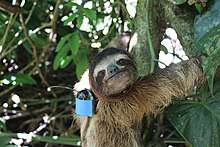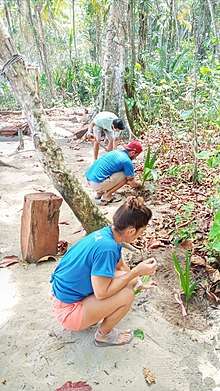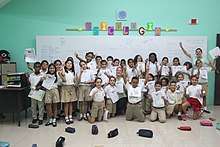The Sloth Conservation Foundation
The Sloth Conservation Foundation (SloCo) is a non-profit organisation based in Costa Rica that is dedicated to the protection of sloths living in wild and human-modified habitats through research, education and community-based conservation.[1][2][3] SloCo was founded in 2017 by sloth researcher Dr. Rebecca Cliffe.[4][5]
 | |
| Founded | 2017 |
|---|---|
| Founder | Dr. Rebecca Cliffe |
| Type | Non-profit organization |
| Purpose | Wildlife conservation |
| Location |
|
Region | South Caribbean of Costa Rica |
| Website | slothconservation |
SloCo is a local non-profit focused on a community-based approach that encourage people and sloths to coexist in a mutually beneficial way.[6]
History

While researching sloths in Costa Rica, Panama, Colombia and Brazil over a period of 10 years, Dr. Cliffe witnessed firsthand the various threats faced by wild sloth populations.[7] SloCo was born out of the need to protect wild sloth populations while furthering the scientific understanding of these poorly understood species.[8][9]
Activities

Loss of habitat due to rainforest urbanisation (including power line electrocutions, dog attacks and traffic collisions) agriculture, climate change,[10] wildlife trade and irresponsible ecotourism (i.e. wildlife selfies) are some of the main threats that sloths face.[11] Sloths are now considered to be a conservation concern in Costa Rica,[12] and, according to a 2017 report published by the World Animal Protection, Costa Rica is one of the top ten worst countries for selfies with wild animals.[13]

Combating habitat fragmentation

Due to their slow nature and highly specialized arboreal lifestyle, sloths are particularly sensitive to the effects of habitat fragmentation and degradation.[14][15] Without a natural or artificial canopy bridge, the only way for a sloth to cross between trees in disturbed areas is by crawling on the ground. Crossing on the ground takes a lot of time and energy as their specialised muscle structure is adapted for hanging in trees, and, as a result, they often get hit by cars while crossing roads.[16][17]
To combat the effects of development, SloCo restores and protects critical sloth habitat through reforestation with tree species favoured by sloths. As a part of their Connected Gardens Project, SloCo installs ‘sloth crossing’ canopy bridges to connect forest fragments in disturbed areas.[18] These bridges give sloths and other wildlife a safe way to travel across roads and navigate urban areas without having to risk coming to the ground.
Preventing dog attacks and electrocutions
When sloths come to the ground they are at a higher risk for dog attacks, which are a leading cause of death for sloths in Costa Rica.[19][20] With the aim of reducing the probability of dog attacks on sloths, SloCo funds the sterilization of stray dogs, as part of their Oh My Dog campaign, to reduce the overall number of dogs roaming freely in Costa Rica.[21] SloCo also provides funding to insulate power lines to prevent the electrocution of sloths and other types of wildlife, which number in the thousands every year in Costa Rica.[22][23]
Teaching responsible tourism

SloCo coordinates online and local education programs to encourage the protection rather than the exploitation of wildlife. Awareness is raised on the issue of wildlife trade through educational campaigns and speaking out against organizations that exploit wildlife. Due to pressure from SloCo and other concerned parties, two organizations known for their exploitation of sloths and other wildlife (Dade City’s Wild Things and Alligator Attraction at John's Pass) have ceased these activities.[24][25]
Conducting research
To further ongoing conservation projects, SloCo funds and coordinates high-quality scientific research on sloths published in open-access, peer-reviewed journals.[26][27][28][29] The director of SloCo, Rebecca Cliffe has published various studies providing new insights into the biology, ecology, genetics and physiology of all six sloth species and continues to conduct research to improve the scientific understanding and conservation efforts of sloths in the wild.[30][31]
External links
References
- "Charity Details". beta.charitycommission.gov.uk. Retrieved 2020-05-20.
- "The Sloth Conservation Foundation | NGO Explorer". ngoexplorer.org. Retrieved 2020-05-20.
- "SLOTH CONSERVATION". Slothville. Retrieved 2020-05-20.
- "Dr Rebecca Cliffe of Penwortham reveals all about working in the jungle in her book Sloths: Life in the Slow Lane". www.lep.co.uk. Retrieved 2020-05-20.
- "Sloths Act Like Birds and Reptiles in This Bizarre Way". Animals. 2018-10-01. Retrieved 2020-05-20.
- "The Sloth Conservation Foundation is embarking on a major reforestation project in the South Caribbean". www.puertoviejosatellite.com (in Spanish). Retrieved 2020-05-20.
- "Dr Rebecca Cliffe of Penwortham reveals all about working in the jungle in her book Sloths: Life in the Slow Lane". www.lep.co.uk. Retrieved 2020-05-20.
- "Becky Cliffe". The Conversation. Retrieved 2020-05-20.
- Cliffe, Rebecca N.; Haupt, Ryan J.; Avey-Arroyo, Judy A.; Wilson, Rory P. (2015-04-02). "Sloths like it hot: ambient temperature modulates food intake in the brown-throated sloth (Bradypus variegatus)". PeerJ. 3: e875. doi:10.7717/peerj.875. ISSN 2167-8359. PMC 4389270. PMID 25861559.
- Cliffe, Rebecca N.; Haupt, Ryan J.; Avey-Arroyo, Judy A.; Wilson, Rory P. (2015-04-02). "Sloths like it hot: ambient temperature modulates food intake in the brown-throated sloth (Bradypus variegatus)". PeerJ. 3: e875. doi:10.7717/peerj.875. ISSN 2167-8359. PMC 4389270. PMID 25861559.
- Nuwer, Rachel. "Sloths Are Number One on the List of Illegally Traded Pets from Colombia". Smithsonian Magazine. Retrieved 2020-05-20.
- Cm, Paola. "Lista de especies, endemismo y conservacion de mamiferos en Costa Rica". Cite journal requires
|journal=(help) - "Costa Rica urges tourists not to take wildlife selfies | World Animal Protection". www.worldanimalprotection.org. Retrieved 2020-05-20.
- Garcés-Restrepo, Mario F.; Peery, M. Zachariah; Pauli, Jonathan N. (2019-01-16). "The demography of a resource specialist in the tropics: Cecropia trees and the fitness of three-toed sloths". Proceedings of the Royal Society B: Biological Sciences. 286 (1894): 20182206. doi:10.1098/rspb.2018.2206. PMC 6367172. PMID 30963880.
- Garcés‐Restrepo, Mario F.; Pauli, Jonathan N.; Peery, M. Zachariah (2018). "Natal dispersal of tree sloths in a human-dominated landscape: Implications for tropical biodiversity conservation". Journal of Applied Ecology. 55 (5): 2253–2262. doi:10.1111/1365-2664.13138. ISSN 1365-2664.
- Olson, Rachel A.; Glenn, Zachary D.; Cliffe, Rebecca N.; Butcher, Michael T. (2018-12-01). "Architectural Properties of Sloth Forelimb Muscles (Pilosa: Bradypodidae)". Journal of Mammalian Evolution. 25 (4): 573–588. doi:10.1007/s10914-017-9411-z. ISSN 1573-7055.
- "New traffic signs aim to reduce wildlife deaths on Costa Rica's roads". The Tico Times Costa Rica. Retrieved 2020-05-20.
- "How do we solve a problem like a sloth?". NatureSpy. 2019-09-12. Retrieved 2020-05-20.
- "Sloth Released Into the Wild After Surviving Dog Attack". beastly.barcroft.tv. Retrieved 2020-05-20.
- Venema, Vibeke (2014-04-04). "The woman who got 'slothified'". BBC News. Retrieved 2020-05-20.
- "A Million Dogs Roam the Streets in Costa Rica". Costa Rica Star News. 2013-06-30. Retrieved 2020-05-20.
- "Shock Free Zone". www.jaguarrescue.foundation. Retrieved 2020-05-20.
- "A Shocking Problem: Wildlife Electrocutions in Costa Rica". Undark Magazine. 2018-06-13. Retrieved 2020-05-20.
- "Sloth yoga canceled in Madeira Beach after online backlash". WFTS. 2019-12-20. Retrieved 2020-05-20.
- "Dade City's Wild Things closes amid legal fight. Its last 6 tigers are moved". Tampa Bay Times. Retrieved 2020-05-20.
- Cliffe, Rebecca N.; Avey-Arroyo, Judy A.; Arroyo, Francisco J.; Holton, Mark D.; Wilson, Rory P. (2014-04-30). "Mitigating the squash effect: sloths breathe easily upside down". Biology Letters. 10 (4): 20140172. doi:10.1098/rsbl.2014.0172. PMC 4013704. PMID 24759371.
- Cliffe, Rebecca Naomi; Scantlebury, David Michael; Kennedy, Sarah Jane; Avey-Arroyo, Judy; Mindich, Daniel; Wilson, Rory Paul (2018-09-19). "The metabolic response of the Bradypus sloth to temperature". PeerJ. 6: e5600. doi:10.7717/peerj.5600. ISSN 2167-8359. PMC 6151113. PMID 30258712.
- Olson, Rachel A.; Glenn, Zachary D.; Cliffe, Rebecca N.; Butcher, Michael T. (2018-12-01). "Architectural Properties of Sloth Forelimb Muscles (Pilosa: Bradypodidae)". Journal of Mammalian Evolution. 25 (4): 573–588. doi:10.1007/s10914-017-9411-z. ISSN 1573-7055.
- Spainhower, Kyle B.; Cliffe, Rebecca N.; Metz, Allan K.; Barkett, Ernest M.; Kiraly, Paije M.; Thomas, Dylan R.; Kennedy, Sarah J.; Avey-Arroyo, Judy A.; Butcher, Michael T. (2018-09-01). "Cheap labor: myosin fiber type expression and enzyme activity in the forelimb musculature of sloths (Pilosa: Xenarthra)". Journal of Applied Physiology. 125 (3): 799–811. doi:10.1152/japplphysiol.01118.2017. ISSN 8750-7587. PMID 29722617.
- "Dr Rebecca Cliffe of Penwortham reveals all about working in the jungle in her book Sloths: Life in the Slow Lane". www.lep.co.uk. Retrieved 2020-05-20.
- "Sloths Act Like Birds and Reptiles in This Bizarre Way". Animals. 2018-10-01. Retrieved 2020-05-20.